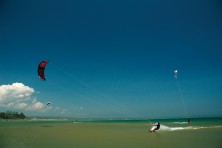Against the Wind
- Share
- Tweet
- Pin
- Share

Wisconsin INDependent Citizens Opposing Windturbine Sites, or WINDCOWS, posted signs in Kewaunee County expressing their opposition to wind power. Photo by Len Villano.
New statewide wind turbine siting rules created by the Wisconsin Public Service Commission finally went into effect March 16 after years of discussion, but opponents of wind power say the rules don’t go far enough to protect property values and public health.
Thanks to an extra year of delay in enacting the rules, those opponents may not have to worry about any new turbines in the state in the immediate future.
The Wisconsin Realtors Association lobbied hard against the new rules, and when Republicans took over the governor’s office and the state legislature after the November 2010 elections, one of their first moves was to suspend the implementation of the new siting rules that were supposed to take effect March 1, 2011. At the time there were seven wind farm proposals in development for the state, but all have since pulled back from their Wisconsin plans.
Michael Vickerman of Renew Wisconsin says wind developers pulled out due to uncertainty about the state’s wind power environment. Today there are no utility-scale projects underway or planned in the state.
“The delay essentially said that Wisconsin is closed to wind development,” Vickerman said. “Other states in the Midwest have soaked up the construction activity.”
Iowa has 792 MW of wind power projects in process and 3,738 MW of existing wind power generation. Illinois has 563 MW in process, and Minnesota has 61 MW in process.
Ron Heuer of Kewaunee County continues to fight to unsettle wind power’s tenuous foothold in the state. Heuer is part of an organization, Wisconsin INDependent Citizens Opposing Windturbine Sites, or WINDCOWS, organized to fight wind farm proposals in the state.
“Wind power is not an opportunity,” Heuer says, “it’s a problem. It destroys the value of real estate near turbines.”
Deciphering the impact of wind farms on property values is difficult. The U.S. Department of Energy funded a study in 2009 by the Lawrence Berkely National Laboratory which reviewed wind projects in 10 states (including one in Kewaunee County) and found that “proximity to wind energy facilities does not have a pervasive or widespread adverse effect on the property values of nearby homes.”
Several studies produced by or funded by wind opponents and real estate groups, however, estimate that wind farms drop values by as much as 40 percent.
Heuer also believes the turbines cause health problems for those who live nearby them due to low-frequency sound emitted by the whirling of the blades and the shadow flicker caused at certain times of the day.
Though some health officials have expressed concern about such problems, there is little definitive evidence of health problems caused by wind turbines. Vickerman said there is no research that suggests a causal connection between turbines and health issues.

Thirty-one wind turbines have been sited in Kewaunee County since 1999. Delays in implementing the state’s new wind turbine siting rules caused developers of seven wind farm proposals throughout the state to halt their plans and move to other states in the Midwest. Photo by Len Villano.
Kewaunee County Administrator Ed Dorner said he has not heard of any reports of health problems attributable to the 31 wind turbines that have been sited in the county since 1999. Dale Engebose, board chairman for the Town of Lincoln, home to several of the Kewaunee turbines, said he hasn’t heard of any either.
The state’s new rules require that turbines not emit sounds above 45 decibels at night and 50 decibels during the day.
“In general we deal with sound above 45 decibels constantly in daily life,” Vickerman said. “It essentially always comes back to the visual impact. If you’re surrounded by them I can see that response.”
But Vickerman said those who site aesthetic concerns don’t balance those complaints with the reality that coal – the number one source of electric power in the United States – devastates natural areas and waterways through mountain-top removal mining practices.
The state’s new rules also require that turbines be located at a distance from neighboring property lines of 1.1 times the maximum blade tip height. While the wind farms in Kewaunee have turbines reaching 292 feet, the newest wind farms feature turbines that reach a height of nearly 500 feet.
Residences not owned by the person on whose property the turbine is sited must be 1,250 feet or 3.1 times the maximum blade tip height from the turbine. They must also be designed so that no owner of a nearby dwelling will experience more than 30 hours of shadow flicker per year.
Wind power has also come under a new wave of criticism for being heavily subsidized by federal energy programs.
“We shouldn’t be building these anywhere,” said Heuer, who said he favors nuclear power. “They wouldn’t be viable at all without subsidies.”
But every form of electric generation in the United States is heavily subsidized through federal tax credits, access to public lands, development incentives, and externalized costs associated with public health issues resulting from the extraction and use of fuels like coal, oil, and natural gas.
Kewaunee County benefits handsomely from the presence of the wind farms. The utilities pay a tax to the state, a portion of which is returned to the municipality where the farm is located.
Over 30 years, the 14-turbine Wisconsin Public Service wind farm in the Town of Lincoln will generate estimated revenue of $200,000 for Lincoln and $375,000 for Kewaunee County.
The farm in Roserie, owned by Madison Gas and Electric Company, pays $19,000 per year to Kewaunee County, $22,235 to Red River Township, and $19,765 to Lincoln Township.


